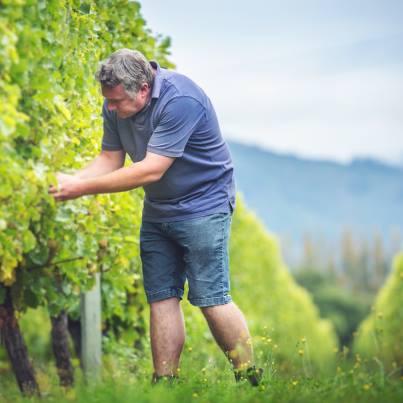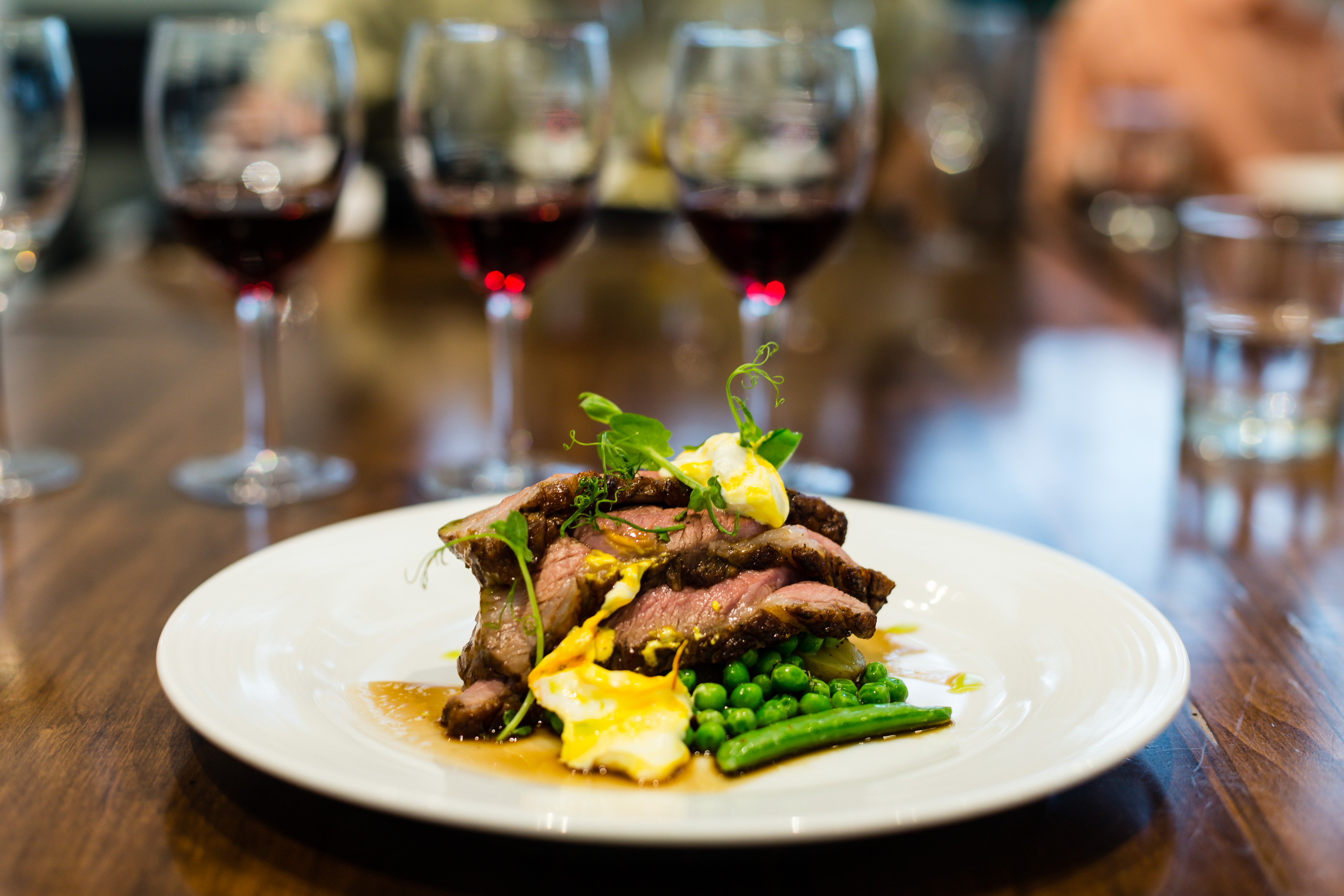New Zealand is often referred to as the most idyllic place to live. It’s micro-climates lends itself to multiple uses including producing some of the best food and wine offered in the world. On a recent trip to Toronto, New Zealand Winemaker David Edmonds tells us to put the country on our bucket lists. So while we’re saving up for that big trip, we can still get a taste of what the country has to offer right here.
David was born just across the Cook Strait in New Zealand’s capital city, Wellington. Coincidentally, or maybe destiny, that same year saw the first commercial vines planted in Marlborough. As he grew up, David headed to Hawke’s Bay in North Island for his first vintage, unsure whether to pursue viticulture or winemaking. It didn’t take him long to make up his mind. “I was hooked on winemaking by lunchtime on the first day,” he says.
After experiencing a few vintages in California, he returned to Hawke’s Bay and then set sights on Marlborough for the region’s famous Sauvignon Blanc. David joined Nobilo Wines in 2002 after touring the vineyards. He has a passion and in-depth knowledge of the unique flavour profiles of the various vineyards throughout the region.
We had a chance to chat with David on his recent visit to Oliver & Bonacini Cafe Grill in Toronto to find out more about his home country and falling in love with Nobilo Wines.
 We’ve heard that New Zealand is beautiful and the climate there is ideal all year round? Is it true? Tell us more?
We’ve heard that New Zealand is beautiful and the climate there is ideal all year round? Is it true? Tell us more?
David: Similar to Canada, New Zealand has four seasons. Marlborough, where the wines are made, is located in the north of the South Island and one of the country’s sunniest and driest regions.
Throughout the region, maritime influences ensure relatively cool conditions during the growing season with afternoon sea breezes every evening. In New Zealand, the influence of the ocean is pronounced: any point in the country is no more than 75 miles from the sea. The days are hot during the summer, but clear, cool nights maintain high acid levels in the grapes and allow for the development of great intensity of flavor—truly ideal conditions for growing grapes. Strong, warm mountain winds prevail throughout October, November and December, enhancing flower fertility and developing fruit. The mountains, themselves, protect the grapes from any cold southerly storms. Spring frosts are rare, but late season frosts can be a potential hazard during the latter stages of harvest.
We often here about how wines in different countries often take on the notes/hints of what else is growing around the same region. What’s are your wines known for?
David: Nobilo wines are crafted from grapes from both the Awatere and Wairau valleys, with a slight emphasis on fruit from the smaller Awatere Valley. In general, Sauvignon Blanc grapes from the Awatere offer more herbal characters, while those from the Wairau offer more tropical fruit flavors. When blended together, they create a well-balanced wine with complexity of flavour.
 How did the wine industry start in New Zealand?
How did the wine industry start in New Zealand?
David: With the threat of war looming, Nikola Nobilo, a stonemason at the time, and his wife Zuva, left their home on the Croatian island of Korcula in the 1930s to seek a new life in New Zealand. When they arrived, they were met by a unique culture quite different from that of their European homeland. One of the most noticeable differences was a society that did not embrace drinking wine with meals.
At the time of their arrival, the New Zealand wine industry was virtually non-existent. In fact, the country’s liquor laws did not even allow wine to be served in restaurants. Yet, the Nobilo family had brought with them over 300 years of European winemaking tradition. In 1943, the family planted their first vines in their new home in Huapai, west of Auckland, making wine with the initial intention of sharing it amongst their family and friends.
In the early years, they struggled with Nikola having no choice but to make his own equipment and maintain a working farm to financially support his family while he nurtured his wine business. Along with other Croatian immigrants, he actively lobbied the government, leading the charge to the eventual overturning of the country’s antiquated liquor laws. In the 1970s, he then led the move to premium varietals, such as Sauvignon Blanc and Pinot Noir, and the development of new winegrowing regions, including Marlborough. Nobilo was also one of the first producers to make a New Zealand Chardonnay.
 As the fall season approaches and we start looking for comfort foods again, what are your favourite dishes and how would you pair them to your wines?
As the fall season approaches and we start looking for comfort foods again, what are your favourite dishes and how would you pair them to your wines?
David: The bright juicy acidity of Nobilo Regional Collection Sauvignon Blanc pairs perfectly with some of the colder season’s more richer dishes. The acidity of the wine helps to break that richness of the foods, while adding some vibrant tropical fruit notes like pineapple, melon and passion fruit.
If we wanted to have a New Zealand themed dinner for guests, what are some dishes we must serve up?
David: Lamb is the obvious must-have for a main course – we have a great recipe we’ve paired with our Nobilo Icon Pinot Noir.
But oysters and Sauvignon Blanc is also a classic pairing and perfect to kick-off to any meal.
Here are two great recipes to try for your own New Zealand inspired meal at home create by Chef Riley of Oliver & Bonacini Cafe Grill…
Roasted Lamb Rump with Potatoes, Peas, and Saffron Labna (serves 4)
Ingredients
- 800-1000 g lamb rump
- 400 g fingerling potatoes
- 200 g peas
- 10 bay leaves
- 150 g yogurt
- Pinch of saffron
- 1 L unsalted veal stock
- 40 g mint
- 1 shallot, sliced
- 2 cloves garlic, sliced
- 2 cloves garlic, lightly crushed
- 30 g butter
- 100 ml Nobilo Icon Pinot Noir
- 2 + 2 sprigs of thyme
- Red wine vinegar, if needed
Method
- Combine yogurt and saffron in a bowl with pinch of salt. Line a sieve with cheese cloth and place sieve in something to catch liquid. Pour yogurt into cheese cloth and let strain at least 6 hours.
- Clean lamb by removing excess fat and silver skin. Discard fat and keep silver skin for jus. Score the skin.
- In a sauce pan on medium-high heat, brown lamb skin until deep brown. Add sliced shallots and garlic; cook until just starting to brown. Deglaze with red wine and reduce until almost gone. Add veal stock and reduce until thick. Turn off the heat and add the thyme. Season with salt and red wine vinegar if needed, depending on the acidity of the wine. Allow to cool slightly, strain and cool.
- In a large pot, cover potatoes with water, then add bay leaves and salt. Cook until a knife slides easily into the flesh. Strain and allow to cool.
 Smoked Tomato Soup with Miso Crème Fraîche (serves 6)
Smoked Tomato Soup with Miso Crème Fraîche (serves 6)
Tomato Soup Ingredients
- 5 kg ripe beefsteak tomatoes
- 1 bulb fennel, thinly sliced
- 2 cups shallot, thinly sliced
- 4 cloves garlic, minced
- 1 celery stalk, sliced
- 1 tsp smoked paprika
- 4 tbsp sherry vinegar
- 1/3 cup Nobilo Regional Collection Sauvignon Blanc
- 2 sprig tarragon
- 1 sprig thyme
- 1/4 cup good-quality olive oil
Method
- Get your smoker going to 160⁰F/70⁰C.
- Remove core and cut tomato into quarters; season with salt, pepper and olive oil. Place in smoker and smoke for 10 minutes.
- Sweat shallots, fennel, garlic and celery until soft. Add paprika and cook for another minute.
- Deglaze with vinegar and reduce.
- Add wine and reduce.
- Add tomatoes and all their juice. Break up tomatoes with a wooden spoon. Simmer until all cooked, about 20 minutes.
- Remove tarragon and thyme. Season with salt and blend in bar blender, pass through a fine sieve, and adjust seasoning.
Miso Crème Fraîche Ingredients
- 1/2 cup crème fraîche
- 2 tsp white miso
- 1/8 cup chives
Method
- Combine crème fraîche with white miso and chives.
- Mix together and refrigerate for at least two hours.
- Garnish soup with olive oil, fresh basil and miso crème fraîche.

Leave a Reply